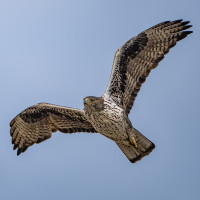Descrição
A long cycle route starts here but of more interest to birdwatchers is the convenient c4-5 km circular walk through pine woods to a ridge and back down to the main track. The woodlands hold Felosa de Bonelli and Chapim-de-poupa, open areas have Cia, Escrevedeira-de-garganta-preta and Cotovia-pequena and the low scrub a variety of ‘Sylvia’ warblers such as Papa-amoras-comum, Toutinegra-de-cabeça-preta and Felosa-do-mato. As with all footpaths beside the A 381 this is a good location to look for raptors particularly in spring and autumn when Águia-calçada, Milhafre-preto, Bútio-vespeiro and the odd Abutre do Egipto (plus Cegonha-preta) pass through. Águia-cobreira (spring-autumn), Grifo-comum , Gavião da Europa and Águia-d'asa-redonda frequently appear but if you're lucky you may spot Águia de Bonelli or Açor here. During passage periods expect Abelharuco-comum and pretty much any small passerine migrant.
Detalhes
Acesso
Take Exit 66 off the A 381 and then the service road south for just under 2km and pull over on to a dirt track on your left to explore the signposted Sendero La Teja Park and follow the paths.
Terreno e Habitat
Floresta , Árvores e arbustos dispersos , MontanhaCondições
MontanhosoCaminho circular
Simé útil um telescópio?
NãoBoa temporada de observação de aves
Primavera , OutonoMelhor hora para visitar
Migração da primavera , Primavera , Outono , Migração de outonoRota
Estrada não pavimentada , Caminho estreitoCaminho dificil
ExtenuanteAcessível por
Pé , BicicletaAbrigo/plataforma deobservação de aves
NãoInformação extra
The tracks here provide a variety of 'pan handle' walks from 4 km upwards allowing you to tailor your walk to your individual requirements most of the walks are fairly easy but there are several steep sections. Look out for various orchid species and the local Portuguese Sundew (Drosophyllum lusitanicum) which, unlike sundews in northern Europe, has attractive pale yellow flower making it easy to locate.





